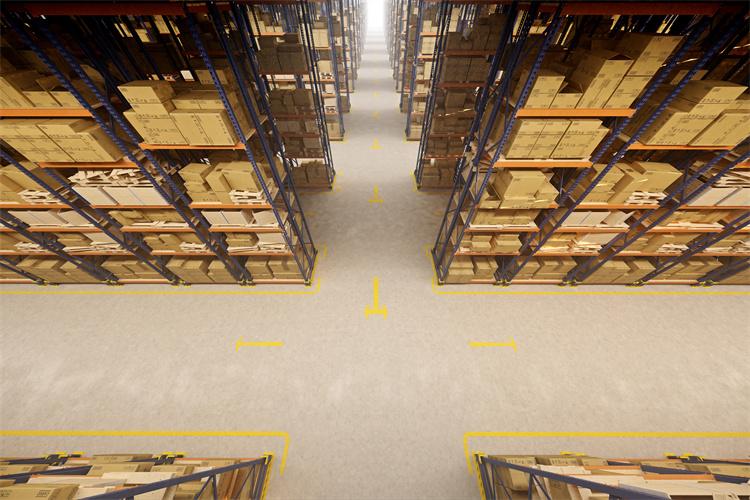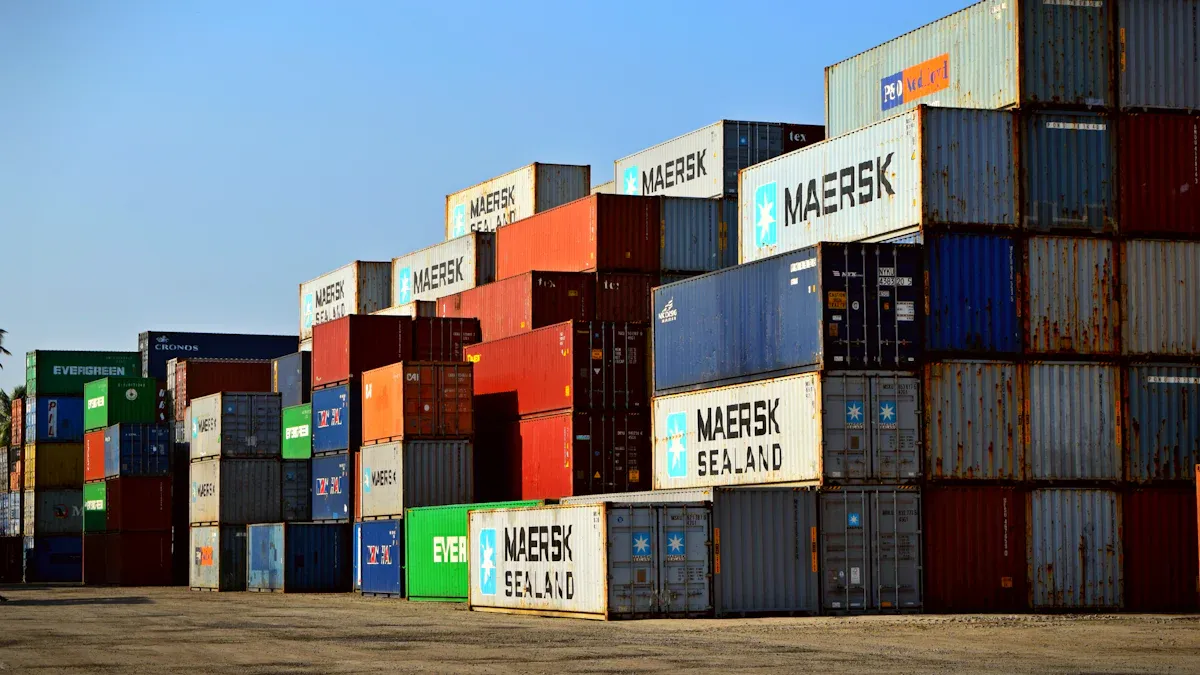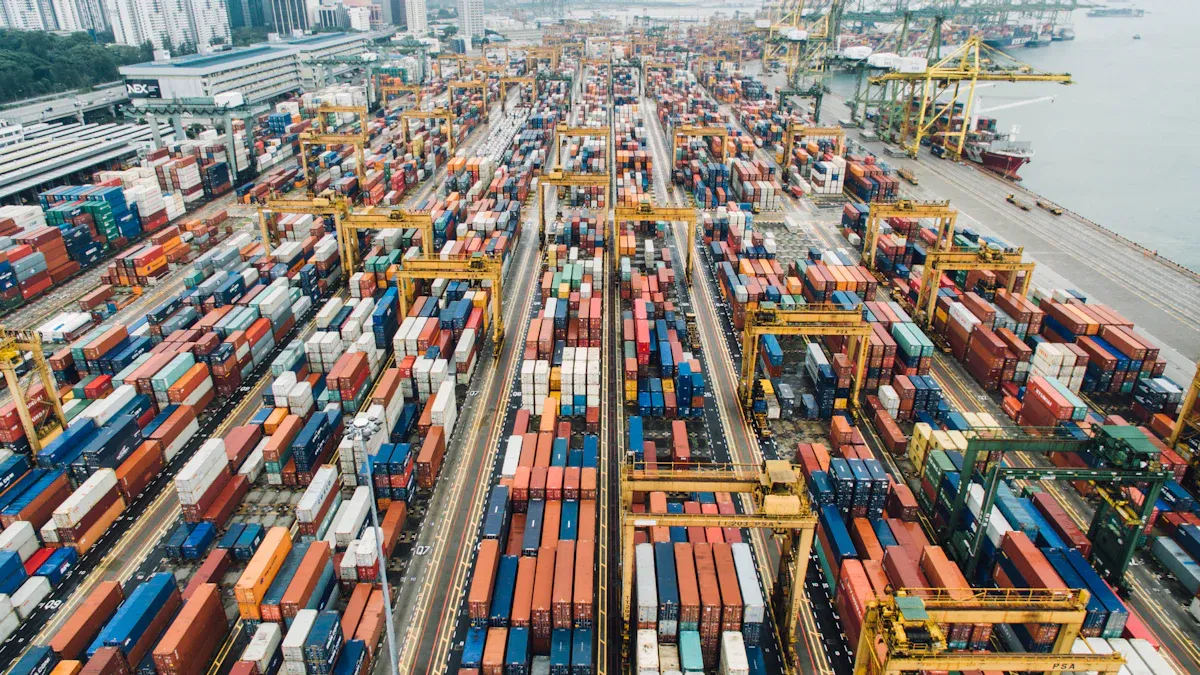How Tariffs Reshape Global Trade and Supply Chains

The impact of tariffs significantly affects how goods move between countries. A tariff acts like a tax on items imported from other nations, altering trade dynamics by raising costs and influencing consumer purchasing decisions. In 2025, the U.S. implemented a 10% tariff, marking the highest rates since the 1970s. This has raised concerns among many manufacturers, with about 73% indicating that trade issues, including the impact of tariffs, are their most pressing challenge. Understanding how tariffs work is essential for recognizing changes in prices, supply chains, and the overall economy.
Key Takeaways
Tariffs make imported goods cost more, raising prices for buyers.
Companies can handle tariffs by using different suppliers and trade deals.
Tools like JUSDA and JusTrade simplify customs and fix supply issues.
Understanding the Impact of Tariffs
What Are Tariffs?
A tariff is a tax on goods from other countries. It makes imported items cost more, so people buy local products instead. In history, tariffs have shaped economies in big ways. For instance, the Tariff Act of 1789 was the first U.S. national tax. It charged 5% to 15% on imports, funding the government and helping industries like steel and textiles grow. Over the years, tariffs became a major part of trade rules, affecting global markets and economies.
Types of Tariffs and Their Purposes
Governments use tariffs for different reasons. These include:
Ad Valorem Tariffs: A percentage of the item’s price. For example, a 10% tariff on cars adds 10% to their cost.
Specific Tariffs: A set fee for each item. For instance, $5 for every barrel of imported oil.
Tariff-Rate Quotas: A smaller tax on a limited amount, with higher taxes on extra amounts. For example, a 500,000 metric ton limit for steel products.
In the past, tariffs helped new industries and raised money. In the 1800s, the U.S. used tariffs to grow its steel and textile industries. Recently, in April 2025, the U.S. added a 10% tariff on all imports. This raised the average tariff to 24%, the highest in over 100 years.
Type of Tariff | Description | Example |
|---|---|---|
Ad Valorem Tariffs | Percentage of the product’s value | 10% tariff on imported cars |
Specific Tariffs | Fixed fee per unit of goods | $5 tariff on each barrel of imported oil |
Tariff-Rate Quotas | Lower tax on a certain quantity, higher on excess | 500,000 metric tons quota for steel products |
How Tariffs Are Collected and Enforced
Governments collect tariffs when goods enter the country. Customs workers calculate the tax based on the type and value of the goods. For example, an ad valorem tariff needs the product’s value to find the right percentage. Tools like JusTrade’s SAAS platform use AI to make this process faster and more accurate. This helps governments collect money and manage trade properly.
📊 Did You Know? In 2018, the U.S. collected $41.6 billion in tariffs. By 2019, this grew to $71.9 billion, showing how important tariffs are in global trade.
The Tariff Impact on Global Trade

Changes in Trade Volumes and Patterns
Tariffs change how goods move between countries. Higher tariffs make importing goods more expensive. This can hurt businesses and raise prices for buyers. For example:
Tariffs on key materials, like steel, increase production costs. Companies then charge customers more.
Countries facing tariffs may trade with new partners, changing old trade routes.
Global supply chains are deeply connected. A tariff in one country can affect the whole system. This impacts businesses and people everywhere. Studies show even small tariff increases change trade patterns. For example, a 25% tariff on steel and aluminum nearly doubles the Average Effective Tariff Rate (AETR) from 2.2% to 4.4%.
📊 Quick Fact: In Canada, tariffs raised the AETR from 0.1% to 1.5%. In Mexico, it went from 0.2% to 2.8%.
These shifts show how tariffs reduce trade and force countries to adjust.
Tariffs as a Tool in Trade Wars
Tariffs are often used in trade wars. Governments use them to protect local industries or fight back against other nations. But this can cause problems for both sides. For example, the USITC found tariffs helped protected industries grow by $2.8 billion. At the same time, other industries lost $3.4 billion.
Trade wars also hurt jobs and economies. The IMF found surprise tariffs cut imports more than exports. Removing these tariffs could grow the U.S. economy by 4% in three years. But if other countries retaliate, it can make things worse. For example, foreign tariffs hurt U.S. farmers, causing job losses in agriculture.
💡 Did You Know? By 2024, higher tariffs collected $264 billion in customs duties. But this added an average $625 yearly tax per household, reducing spending power.
These examples show that while tariffs aim to protect, they can cause bigger economic problems.
Case Studies: Real-World Examples of Tariff Effects
Real-life examples show how tariffs affect industries. Here are some cases:
Industry | Impact of Tariffs |
|---|---|
Automotive | Steel and aluminum tariffs raised costs, pushing local production. |
Technology | Tariffs on hardware and services made companies change strategies. |
Agriculture | Tariffs disrupted food supply chains, hurting exports and farming. |
These examples show how tariffs reshape industries. In the car industry, higher costs made companies build closer to buyers. In farming, tariffs hurt exports, forcing farmers to adapt.
🌍 Global Perspective: Tariffs don’t just affect one country. They spread through global supply chains, changing industries worldwide.
These examples help explain how tariffs change trade and affect businesses everywhere.
Supply Chain Disruptions and Adjustments

How Tariffs Change Supply Chains
Tariffs raise costs and make businesses change their supply chains. When imported materials cost more, companies spend more to produce goods. To save money, businesses change suppliers or move production. This takes time and costs a lot. For example:
Over 40% of imports come from tariffed countries, raising costs.
Companies store extra materials to avoid problems, increasing storage costs.
Businesses find new suppliers, but this adds paperwork and expenses.
These changes show how tariffs force companies to adjust. Businesses must find smart ways to stay profitable and efficient.
How JUSDA Helps with Supply Chain Problems
JUSDA helps companies handle supply chain issues caused by tariffs. Its platform uses AI and blockchain to make work easier. It helps track shipments, predict demand, and manage inventory. JUSDA connects systems to reduce mistakes and improve decisions. For example, JUSDA has helped companies cut shipping costs and deliver faster. These tools help businesses deal with tariff problems while keeping operations smooth.
JusTrade Makes Customs Clearance Easier
JusTrade helps businesses clear customs without delays. Its platform uses AI to sort goods and manage shipping. This saves time and avoids rule-breaking. JusTrade links buying, shipping, and finance teams for better teamwork. With services in 20 countries, JusTrade helps companies follow customs rules easily. By using JusTrade, businesses can focus on making products without worrying about tariff troubles.
Economic and Consumer Implications of Tariffs
Effects on Consumer Prices and Inflation
Tariffs make imported goods cost more for buyers. Businesses pay higher costs and pass them to shoppers. For example, tariffs on Chinese goods raised laptop prices by 46%. Smartphone prices also went up by 26%. These increases add to inflation as companies adjust prices to stay profitable.
Tariffs affect more than just the targeted items. A study found that tariffs on washing machines also raised dryer prices. This shows how tariffs can cause market confusion. The PMI Output Prices Index says one-third of producers blame tariffs for higher costs. These costs lead to higher prices for everyday products.
Evidence Type | Description |
|---|---|
Price Increases | Tariffs on laptops and smartphones caused big price jumps. |
Inflation Impact | Businesses raised prices to cover tariff costs, adding to inflation. |
Broader Market Effects | Tariffs on one item raised prices for related goods. |
Business Profitability and Competitive Pressures
Tariffs make it hard for businesses to stay profitable. Companies must either absorb costs or raise prices, which hurts competitiveness. For example:
Tariffs in South Africa caused a 5-10% drop in productivity.
A small tariff increase led to a 0.4% drop in growth over five years.
Removing 2018-2019 tariffs could have boosted U.S. output by 4% in three years.
These examples show how tariffs disrupt business plans and create uncertainty. Companies often change suppliers or move production to stay competitive.
Broader Economic Consequences of Tariff Policies
Tariffs affect entire economies, changing trade and growth. A study on 2018 tariffs showed some firms gained protection, but manufacturing suffered overall. IMF models predict big losses for China and the U.S. from a 25% tariff hike.
Evidence Type | Description |
|---|---|
Microeconomic Analysis | Tariffs hurt manufacturing despite helping some firms. |
General Equilibrium Models | A 25% tariff hike caused big losses for China and the U.S. |
USITC Report | Removing tariffs could boost economic welfare by $3.3 billion. |
Tax Foundation Model | A 10% tariff cut U.S. GDP by 0.7%. |
Tariffs aim to protect industries but often hurt economies. Grocery prices rise when fresh produce faces tariffs. Canada’s energy exports to the U.S. also dropped. These examples show how tariffs bring both challenges and opportunities for countries.
Strategies to Handle Tariff Problems
Using JUSDA to Diversify Supply Chains
Changing your supply chain can lower risks from tariffs. Relying on one supplier or region can cause problems if tariffs rise. Getting materials from different countries helps avoid high tariffs and keeps production steady. JUSDA provides tools to help you diversify your supply chain. Its platform uses smart tech like AI and blockchain to improve operations. It helps you manage suppliers, track shipments, and control inventory quickly.
For example, JUSDA has helped companies move parts of their supply chains to areas with fewer tariffs. This saves money and makes work smoother. With JUSDA’s help, you can adjust to tariffs and stay competitive.
Using Trade Deals and Partnerships
Trade deals and partnerships help reduce tariff problems. These agreements make trading easier and lower costs for businesses. For example, the Regional Comprehensive Economic Partnership (RCEP) lowers tariffs and simplifies trade between member countries. By following these agreements, you can save money and make trade easier.
Here are some helpful strategies and agreements:
Strategy/Agreement | Description |
|---|---|
Product Changes | Changing designs to lower tariff categories. |
Supply Chain Changes | Getting materials from places with fewer tariffs. |
Cost-Saving Adjustments | Cutting costs, like using smaller packaging. |
Trade Agreements | Supporting deals that protect business investments. |
RCEP | Helping goods move freely between member countries. |
Knowing these strategies helps you handle tariff challenges better. Working with groups like JUSDA can make adapting easier.
JusTrade Helps Avoid Customs Delays
Customs delays can slow down your supply chain and raise costs. JusTrade makes customs clearance faster and easier. Its platform uses AI to sort goods and manage shipping well. This reduces mistakes and speeds up customs checks.
JusTrade also connects your buying, shipping, and finance teams for smooth teamwork. Operating in 20 countries, JusTrade ensures you follow customs rules. Using JusTrade helps you avoid delays and focus on growing your business. This is especially helpful for industries like electronics, where fast delivery matters.
Tips for Shoppers to Save Money
Tariffs can make everyday items cost more. But you can save money with these tips:
Buy in Bulk: Buying more at once can save money over time.
Choose Alternatives: Look for local products not affected by tariffs.
Use Discounts: Find coupons and deals to cut costs.
Plan Ahead: Stock up on items before prices go higher.
These tips can help you spend less and manage your budget better.

JUSDA Solutions
To provide you with professional solutions and quotations.
Tariffs change trade, supply chains, and economies by raising costs. For instance, a 60% tariff on Chinese imports may increase inflation by 2.2%. This affects what shoppers pay for goods. To handle these issues, businesses need smart plans. JUSDA and JusTrade offer tools to improve supply chains and make customs easier. These tools help businesses stay strong in tough markets.
See Also
The Importance of Supply Chains in Global Trade
Exploring How Global Trade Policies Affect Economies
Addressing Challenges of Supply Chain Growth Worldwide
The Transformation of Industries Through Cloud Supply Chains
